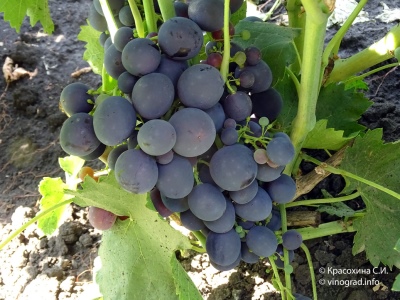
- Authors: Zagorulko Vitaly Vladimirovich
- Appointment: dining room
- Berry color: Navy blue
- Taste: harmonious, varietal
- Ripening period: very early
- Ripening period, days: 105
- Frost resistance, ° C: -23
- Bunch weight, g: 500
- Flower type: bisexual
- Density of the bunch: moderate
The Sphinx is a grape hybrid with exquisite taste. It combines, along with high yield, early maturity and resistance to adverse weather conditions.
Breeding history
Sphinx is a hybrid grape variety, which was bred by the Ukrainian breeder Zagorulko Vitaliy Vladimirovich about 10 years ago by crossing the grape varieties: Strashensky and Timur. The crossing of the common variety of Moldavian table grapes, Straseni, and Timur, which is notable for its early maturity, led to the creation of a hybrid form of the Sphinx, which inherited from these varieties excellent taste, as well as early maturity and resistance to climatic features.
The Sphinx was bred according to the following criteria:
crop stability in all weather conditions;
self-pollination;
original taste;
ease of maintenance.
This variety, due to its unpretentiousness, has become in demand by many summer residents and novice winegrowers.
Description
The Sphinx is a fairly tall plant with fast growth and early maturation of the vine.
The plant tolerates various weather conditions well: from heat to severe frosts, and is also resistant to drought and many pests that destroy grapes. This hybrid is bisexual, bred for self-pollination and has both male and female flowers.
The variety has both advantages and disadvantages. The advantages include:
fast ripening of fruits;
fairly high yield;
large berries and large clusters;
exquisite taste;
frost resistance;
ease of maintenance;
Its disadvantages are:
fear of drafts;
instability of berries to high humidity;
low resistance to diseases of mildew and powdery mildew, characteristic of all grape varieties;
high attractiveness for wasps, which leads to damage to the berries;
impossibility of transportation over long distances.
Ripening period
The Sphinx is characterized by a very early ripening period. Fruit ripening occurs quite quickly: in 100-105 days, while significantly depending on weather conditions.
Bunches
The bunches have a cylindrical-conical shape with a moderate density, depending on the correct care of the plant: timely watering and loosening. The average weight of a bunch is 500-700 g.
Berries
This variety has large berries, ranging in color from dark blue to purple, with an oval or ovoid shape. Sphinx berries have a dense crunchy pulp. The size of the berries ranges from 28 to 32 mm in diameter, while the weight of each berry reaches 8-10 g.
Taste
The taste qualities of the Sphinx are quite consistent with table grapes and are characterized by varietal tastes with shades of both Timur and Strasensky varieties in their harmonious combination.
Yield
Early ripening gives high yields due to the unpretentiousness of the variety to weather conditions and care. Harvesting mainly occurs at the end of summer, but the rate of ripening depends on the weather conditions.


Growing features
When growing the Sphinx, it must be borne in mind that in terms of the strength of its growth, it belongs to vigorous plants. The variety is bisexual, which is characterized by the presence of both male and female flowers, and therefore it is desirable to grow the variety away from other grape species.
Landing
Planting seedlings must be carried out in the period from the last decade of April to the second decade of May. In the autumn, planting should be done before mid-October. Disembarkation should be performed according to the following algorithm:
the sprout is placed in a container of water for 24 hours;
pruning the vine, leaving 4-6 eyes;
a hole is digging with a depth of 70-80 cm and a diameter of about 20-25 cm and is filled with top dressing from humus and phosphate fertilizers;
on this basis, a seedling is placed vertically and covered with earth;
watering is carried out - 1-2 buckets of water.

Pollination
In the process of flowering grapes, the petals of the flower form a corolla in the form of a cap, which flies around before pollination. The Sphinx is a bisexual grape variety, so pollination is a cross-process.
Pruning
It is advisable to cut off old branches in the fall so that the plant does not use its strength and resources during flowering on them. When pruning, it is advisable to leave 4-5 shoots with eyes, while the eyes left on the vine should be 4-6 and no more.



Frost resistance and the need for shelter
Although the Sphinx can be safely attributed to frost-resistant types of grapes: it tolerates frost down to -23 C, but still it is necessary to organize a shelter for it for the winter.

Diseases and pests
The Sphinx is resistant to major diseases and pests, but the Sphinx's immunity should be considered average, and therefore certain prevention against diseases and pests is necessary. Low resistance to diseases - mildew and oidium, only 3.5 points to each - requires constant prevention in the spring.

If the grapes are exposed to any disease or insect, this is always reflected in its appearance.
Storage
It is necessary to collect ripe bunches as soon as they ripen - ripe berries of the Sphinx fall off very quickly. Bunches should be stored in a cool dry place, but not more than a month. Refrigeration is often preferred. Berries of this variety do not tolerate long-term storage, and therefore it is advisable to process them in a short time.
The Sphinx grape is a hybrid variety suitable for cultivation by novice winegrowers. This versatile variety is equally used in the production of wines and juices as well as in confectionery. Drinking it fresh is both pleasant and healthy.











































































